What are the Factors that Affect the Rapid Charge of Battery?
Lithium batteries are called rocking chair batteries since it works by moving charged ions between the positive and negative poles to transfer charge, so as to power an external circuit or charge from an external power source. The battery structure, whether electrochemical or physical, that affects charge transfer during the entire operation of ions and electrons will have an impact on rapid charging performance. For batteries, if you want to improve the power performance, it is necessary to make efforts in all aspects of the whole battery, mainly including positive pole, negative pole, electrolyte, and diaphragm.
Positive pole and negative pole
In fact, almost all kinds of positive electrode materials can be used to make quick rechargeable batteries. The main performance that needs to be guaranteed includes conductance, diffusion, life, safety and proper processing performance. There may be differences in the problems to be solved for each specific material, but the common anode materials can meet these requirements through a series of optimization. Common anode materials include lithium iron phosphate, ternary materials, and lithium manganite, etc.
When a lithium-ion battery is charged, the lithium moves to the negative pole. The high potential brought by the rapid charging current will lead to more negative cathode potential. At this point, the pressure of the negative pole to accept lithium rapidly will be increased, and the tendency of lithium dendrites will also be increased. Therefore, the cathode during quick charging should not only meet the kinetic requirements of lithium diffusion but also solve the security problem caused by the intensified tendency of lithium dendrite formation. Actually, the main technical difficulty of the quick charging core is the insertion of lithium ions in the cathode.
Currently, the dominant negative electrode material in the market is still graphite (accounting for about 90% of the market share). There have been a lot of improvements of hard carbon and soft carbon materials in recent years, while silicon negative electrode material is an important development direction.

Diaphragm
For the power type battery, the high current working provides higher requirements for its safety and life. Ceramic coating diaphragm is being rapidly pushed away due to its high safety and impurities which can consume electrolyte, especially for improving the safety of ternary batteries.
At present, the ceramic diaphragm is mainly used to coat alumina particles on the surface of the traditional diaphragm. The novel approach is to apply solid electrolyte fibers to the diaphragm, which has lower internal resistance, better mechanical support of the diaphragm, and a lower tendency to plug the diaphragm hole during service. The coated diaphragm has good stability, and it is not easy to contract and deform in the short circuit even if the temperature is high.
Electrolyte
The electrolyte has great influence on the performance of the quick-charge lithium-ion battery. In order to ensure the stability and safety of the battery in the quick charge flow, the electrolyte must satisfy the following characteristics. It does not decompose; it is highly conductive; it is inert to the positive and negative material and cannot react or dissolve.
The key to meeting these requirements is to use additives and functional electrolytes. For example, the safety of ternary quick rechargeable batteries is greatly affected by it. It is necessary to add various additives to protect them against high temperature, flame retardant and overcharge, so as to improve their safety to a certain extent. The high-temperature expansion of lithium titanate batteries also depends on high- temperature functional electrolyte to improve.



